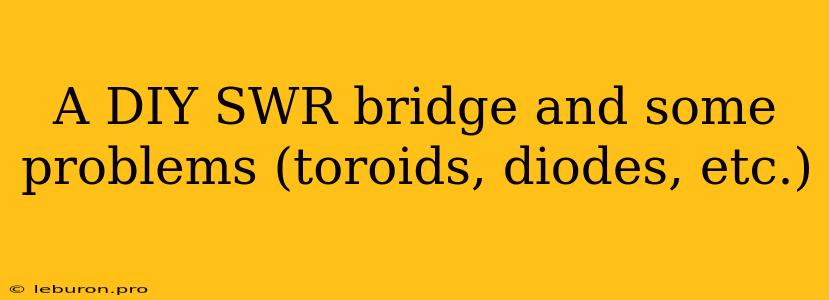Building a DIY SWR bridge can be a rewarding experience for any ham radio enthusiast, allowing you to gain a deeper understanding of your antenna system's performance. However, the journey is not without its challenges, particularly when dealing with components like toroids and diodes. This article explores the process of constructing a DIY SWR bridge, highlighting common problems you might encounter, and providing insights into the crucial role of toroids and diodes in this endeavor.
Understanding SWR and its Importance
Before diving into the specifics of building a DIY SWR bridge, it's essential to grasp the significance of the SWR (Standing Wave Ratio) in ham radio. The SWR reflects the impedance match between your transmitter and antenna. A perfect match (1:1 SWR) ensures maximum power transfer, minimizing signal reflections and maximizing efficiency. However, a mismatch leads to higher SWR values, indicating significant power loss and potential damage to your transmitter.
The Basics of an SWR Bridge
A DIY SWR bridge essentially measures the SWR by comparing the forward and reflected power traveling through your antenna feedline. This information is then used to determine the impedance match. Most DIY SWR bridges utilize a directional coupler, which separates the forward and reflected power. The difference in power levels between the two signals directly correlates to the SWR.
Toroids: The Heart of the Directional Coupler
Toroids play a crucial role in the directional coupler within your DIY SWR bridge. These donut-shaped ferrite cores are specifically designed to efficiently couple magnetic fields. In a DIY SWR bridge, two toroids are typically employed, each wound with a primary winding and a secondary winding. The primary winding is connected to your antenna feedline, while the secondary windings are connected to the bridge's circuitry.
Common Toroid Problems
When working with toroids, certain issues can arise:
- Incorrect core material: Different toroid materials have varying permeability, which affects the impedance matching. Using the wrong material can lead to inaccurate SWR readings.
- Winding errors: Incorrect winding counts or misaligned windings on the toroids will significantly impact the performance of your DIY SWR bridge.
- Loose connections: Ensuring tight connections between the toroids and the bridge's circuitry is crucial. Loose connections can introduce unwanted resistance and disrupt the signal flow.
Diodes: Rectifying the Signals
Diodes are essential in the circuitry of a DIY SWR bridge. Their primary function is to rectify the RF signals generated by the toroids, converting them into DC voltage that can be measured. The rectified DC voltage represents the forward and reflected power levels, allowing you to calculate the SWR.
Common Diode Problems
While diodes are relatively robust components, they can still present challenges:
- Reverse voltage breakdown: Diodes have a maximum reverse voltage rating. Exceeding this rating can lead to damage, rendering the diode unusable.
- Forward voltage drop: Diodes have a small voltage drop when conducting current, which can influence the overall accuracy of your SWR readings.
- Leakage current: Some diodes might exhibit a small amount of leakage current even when reverse-biased, which can interfere with the signal measurements.
Building a Simple DIY SWR Bridge
Here's a simplified guide to building a DIY SWR bridge with the help of toroids and diodes:
Materials:
- Two toroids (FT-240-43 is a common choice)
- Two diodes (1N4148 is a suitable option)
- Two 100 ohm resistors
- A suitable meter for measuring DC voltage
- Wire for winding
- A small project box
Procedure:
- Wind the primary winding of each toroid with about 20 turns of wire.
- Wind the secondary winding of each toroid with about 10 turns of wire.
- Connect the primary windings in series with your antenna feedline.
- Connect each secondary winding through a 100-ohm resistor to one leg of a diode.
- Connect the other legs of the diodes to the positive terminal of your DC meter.
- Connect the negative terminal of your DC meter to a common ground point.
This is a basic schematic; more complex designs might employ a balancing network and other features.
Troubleshooting Common Issues
If your DIY SWR bridge isn't working as expected, here are some common troubleshooting steps:
- Verify the connections: Double-check all connections, ensuring they are tight and secure.
- Inspect the toroids: Ensure the toroids are not damaged and that the windings are correctly aligned.
- Check the diodes: Verify that the diodes are not faulty or damaged. Use a multimeter to check their forward voltage drop and leakage current.
- Calibrate the bridge: You can use a known load or an impedance analyzer to calibrate your DIY SWR bridge for more accurate readings.
Conclusion
Building a DIY SWR bridge offers a valuable learning experience and allows you to gain a deeper understanding of antenna performance. While toroids and diodes are crucial components, it's important to be mindful of potential problems that can arise with these components. Careful selection, proper handling, and troubleshooting techniques are essential for building a reliable and accurate DIY SWR bridge. Remember to always prioritize safety and consult with experienced radio enthusiasts or technicians for guidance and assistance.
